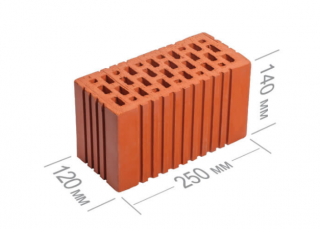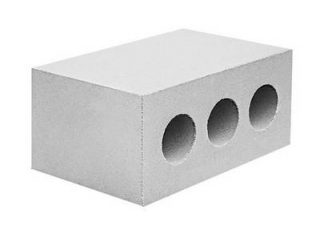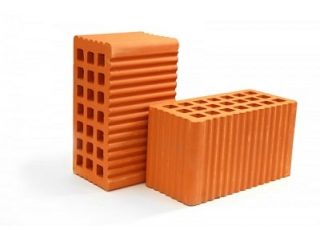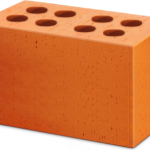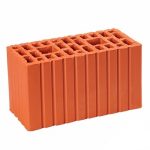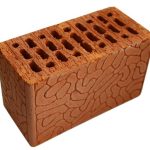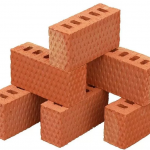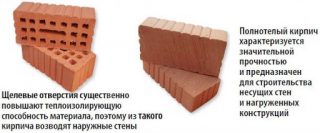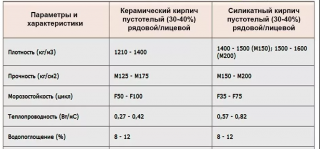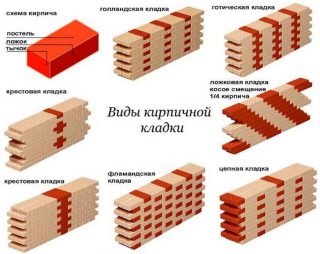The building materials available to a private builder are varied. Bricks are produced in different sizes, shapes, densities, and from different materials. Double brick became very popular in the construction of cottages.
Material description
- width - 120 mm;
- length - 250 mm;
- height - 140 mm.
Compared to the usual single or one and a half, double is distinguished by a much higher height.
Such dimensions facilitate construction, since 1 cube of blocks allows you to build a large area. On the other hand, a double stone weighs more: 5-7.2 kg against 2.5 for single and 3.3 kg for one and a half. Therefore, the actual installation requires more effort.
A double brick is made from different materials. Most famous clay and silicate... The first is made from clay, water and sand in 2 ways.
Prepared mass of clay with a moisture content of up to 30% are fired, and then they form a double brick using the method pressing... This option is used if the stone is intended for construction in areas with high humidity... It absorbs moisture much less.
In a different way a block is immediately formed from the raw material, and then burn his. The proportion of moisture in the clay here is 8–10%.
Silicate brick make from a mixture of lime and quartz sand... The mass is laid in the mold, giving the desired size and appearance, then autoclaved at a temperature + 100-200 ° С and a pressure of 10 atm. Then the material is dried and sorted.
The technical characteristics of the stone do not depend on the size, but on the raw materials and technology used in the manufacture.
Ceramic blocks of large sizes show their advantages to a greater extent. Ceramic itself retains heat better, and with large dimensions and the absence of a large number of seams, the wall turns out to be warmer.
Types of double bricks
The double stone is available in several varieties.
By appointment:
- Ordinary brick - designed for the construction of walls and partitions. A suitable option is chosen by weight and strength, since a building of different heights requires a stone of different strength. For load-bearing walls, a solid and hollow block is taken.
- Facial - it is distinguished by stricter dimensions, precise shape, high uniformity of color and texture. Its purpose is facade decoration. For cladding, you can also take both solid and porous bricks.
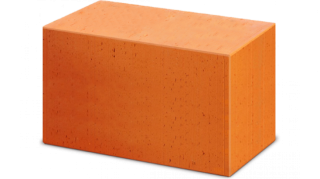
Distinguish between material and by structure... This parameter significantly affects the physical characteristics of the stone.
- Double slot brick - includes many small cavities. Such a stone weighs less, which means that it creates much less load on the foundation. The voids inside are filled with air, and the latter is the best thermal insulation material. Slotted brick retains heat much better. This allows you to reduce wall thickness and reduce construction costs.
- Double corpulent - it is much less common, since its weight is noticeably greater. Such a stone is heavier. If you decide to use it, will have to strengthen the foundation... The thermal conductivity of such a stone is higher, it accumulates heat worse, but it is distinguished by its ability to withstand a higher bearing load. A double solid block is taken for the construction of buildings above 5 floors.
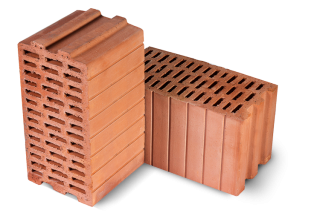
By sight end surface also distinguish between 2 options. However, these varieties appear only in ceramic bricks.
- Flat surface - has a standard look and is laid in the traditional way.
- Model with tongue-and-groove connection involves the formation of grooves and protrusions on the surface. During masonry, they fit into each other, increasing the mechanical strength of the wall. In addition, less glue is required to join them, since such a seam must be made thinner.
The material is produced taking into account the peculiarities of the weather. For northern latitudes, a stone is produced with high frost resistance – up to F50... Bricks are bought for construction on the sea coasts with high moisture resistance... And for residential buildings in dry areas, you can purchase a double silicate block and save on costs.
Characteristics of hollow and solid bricks
Solid brick has no voids. It is a solid solid stone with maximum load-bearing capacity. Characteristics the following.
- Frost resistance clay block hesitates from 35 to 150 cycles depending on the purpose. The silicate indicator is slightly lower - up to 50 complete cycles of freezing and defrosting, therefore, it is used much less often in northern latitudes.
- Thermal conductivity - 0.6-0.7 W / m * Kwhich is not too much. The silicate parameter is even lower - 0.87 W / m * K. A wall made of such material will only be warm if it is thick enough. And since the material is quite expensive, usually the supporting structure is made of double blocks, and they are insulated with other, less expensive means.
- Refractoriness ceramic brick is huge - up to + 1000 ° С... Silicate is less stable, but it is still enough to withstand any fire.
- The most outstanding quality of solid stones - strength... Ceramics withstands stress from 75 to 300 kg / cm²... Silicate indicators are the same.
- Water absorption a clay solid block has the lowest - not more than 3%... This material is used for construction in areas with high humidity. Higher density provides and silicate Main factors - from 6 to 16%.
- Double ceramic bricks with cavities have thermal conductivity coefficient of 0.3-0.4 W / m * K... In middle latitudes, such walls do not need insulation. The thickness of the partition can be reduced without affecting its thermal conductivity. At the void silicate coefficient is higher - up to 0.58 W / m * K.
- Weight items below: hollow double weighs from 5 to 5.4 kg... The walls from it load the foundation less.
- Moisture resistance remains - this parameter does not depend on the number of cracks, but on the quality of the material itself.
- By strength hollow is inferior to its corpulent counterpart. A stone is produced that can withstand up to 125-150 kg / cm².
According to GOST, products containing less than 13% of cavities are considered corpulent. They are lighter in weight, store heat better, but at the same time withstand the same bearing load.
Demand for material
The popularity of the material is explained very simply. Large blocks even with more weight easier to stack... Each row requires less effort, and is noticeably higher in height.This also reduces the consumption of mortar: it is easier to lay a thin, even layer on a large surface.
The walls of their large blocks easier to trim: after all, the fewer joints, the easier it is to level the surface and the easier it is to avoid the appearance of cold bridges.

The nuances of laying double bricks
- the plane of the row must be exactly horizontal and perpendicular to the load vector;
- plane 2 and 3 of the row is perpendicular to plane 1;
- the mass of the upper brick is distributed over the 2 lower ones, which avoids bending forces.
To implement these principles, it is used 3 types of masonry:
- chain - bricks are laid in 1 row alternately with a spoon and a poke, but so that the seam between the stones is in the center of the stone of the previous and next row;
- in 3 levels - in 1 row, blocks are laid with a wide end, and 2 - with a narrow one;
- multi-tiered - a more complex option, designed for the construction of thick walls.
The calculation of the volume of material is performed in the usual way. But at the same time the thickness of the seam must be taken into account: this indicator can change the total by 30%.

